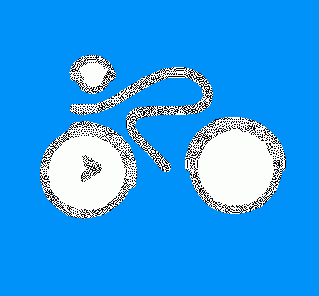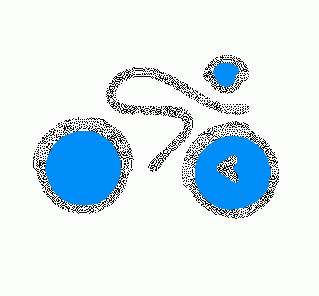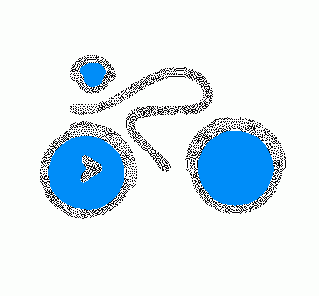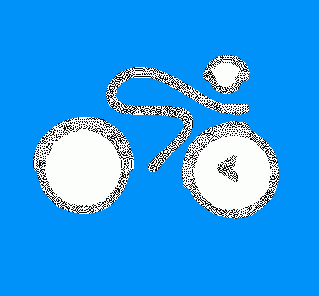| Newsletter - 2001 Archive |

|

|
Cycling Club |

|

|
| Newsletter - 2001 Archive |

|

|
Cycling Club |

|

|
Next--->
I just wanted to give you a quick rundown on how the GPS thing worked for the Mainland 200 k. The short answer is - pretty well. The coordinates were pretty well bang on. The important factor, and what I wanted to test - was if the GPS could warn about turns in time. The answer is, yes and no. It seemed to turn on the 'turn ahead' indication about 50 m before the turn (although I have a feeling it could depend on the current travelling speed). Then, a second of two later the arrow showed the direction of the turn. Now at a 30 kph pace, you do that 50 m in six seconds, and that isn't a lot of time to get into the correct lane and set up the correct 'line'. It is especially frustrating because you have to start watching the display as it counts down from about 100 m, and then wait for the turn indication and then the arrow itself - when you should be watching the road and other vehicles. Incidentally that arrow is always a faithful indication of your direction - for example entering Loomis Trail which is about a 11 o'clock turn. Ideally you would have an audible indication - one tone at 100 m away and two different tones for left and right shortly after that. (The GPS does show the 6-char waypoint name - something like 'Fraser' or '88thav' or 'peacep', but I didn't pay much attention to that - or even the street name.) Of course if you have a stoker - that might make it easier but then I would REALLY want lots of notice about turns.
However consider the lack of a GPS. Then you have to scan a route list, probably after checking the computer trip odometer. I always have trouble picking the right line off the page. Then you have to read the direction indication and street name off that line - all probably without looking up. Then you have to start looking for street signs. I believe that all takes even more time than with a GPS. And it is a real problem in the dark!
One of the best features of the GPS approach is that it presents you with one item at a time - the next turn. That enables you to concentrate on riding until you approach the turn, and then concentrate on the next. Other ways of doing that would also be as effective - I have seen someone with the route on rollers like a scroll with a yellow cursor (if you know who this person is, let me know). It also makes me think that Bikebrain may actually be worthwhile (it is a Palm Pilot app that presents each turn of a route, one by one).
But the GPS has other advantages - It counts down both the distance and time to the next turn so you know exactly when you will get to each control and the finish (I liked knowing exactly when I would get to the top of Kickerville). It shows you the current altitude, which is kind of interesting (low point is Birch Bay and there were several places tied for the max about 60 m). (Are these things smart enough to calibrate on mean sea level?). The screen is backlight so you could theoretically run as fast at night - although that would take some strong faith in technology. But I was going through two sets of batteries on the 200 (which could be stretched to a 300, I think). With a backlight I assume it would be much less. Of course you don't need it to be on all the time (like mine was) - If you are riding out to Manning or up to Darcy or Cache Creek, turning it on every 30 minutes of so would be good enough! I found it could fix a location from startup in about 15 seconds - and update your progress along the route (unless you have gone more than 100 km while it was sleeping - then it gets momentarily confused).
One problem was the number of data points available. The eTrex will store 500 waypoints, which is really a lot. But a single 'route' can only have 50 points, and this 200 had about 85. So I actually ran out of 'route' around Everson. I could have constructed the balance of the route by clearing the old one and building a new one with the 37 remaining waypoints, but that would have taken about 15 minutes at least and would require recognizing the cryptic 6-character names corresponding to the route list. At least 15 minutes, stopped. But very few routes are as convoluted as this 200. Of course I am talking about the cheapest GPS on the market - the Garmin eTrex. Other models might well have more waypoints per route or multiple routes, built-in maps and maybe even audible turn warnings. But they won't cost $200 like mine.
Of course the most difficult problem, is getting the data - finding the coordinates for every turn in the first place and then getting them entered in the GPS. It took me many hours and two programs (MS S&T and Topo!USA). I think in the future I would just enter the official controls and some strategic major turns and perhaps areas which are complicated or unfamiliar. And perhaps the locations of some service stations, ATMs and maybe some restaurants! But I would never travel without a GPS - just knowing where the finish is and when I will get there makes it worth $200. If anyone wants my route sheet with the coordinates, I can email it any time.
_